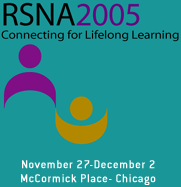
Abstract Archives of the RSNA, 2005
David S. Hirschorn MD, Presenter: Nothing to Disclose
Keith J. Dreyer DO, Abstract Co-Author: Nothing to Disclose
Mannudeep Karanvirsingh Kalra MD, Abstract Co-Author: Nothing to Disclose
Michael M. Maher MD, Abstract Co-Author: Nothing to Disclose
Consumer grade color LCD flat panels meet the requirements of the ACR Standard for luminance. Three megapixel (MP) grayscale displays have become the de facto standard for PACS workstations. However these displays are optimized for high resolution radiographs and cost ten times more than their color LCD counterparts. Consumer LCD displays may be better suited for CT exams due to a closer match of the display resolution (1-2 MP) to the native image size of CT (0.25 MP), which produces considerably faster scrolling in stack mode. This study objectively measures the difference, if any, in diagnostic accuracy for CT exams between consumer grade color LCD displays and medical grade grayscale LCD displays.
Two PACS viewing systems were created. System A had dual 3 MP grayscale LCD displays. System B had dual 1.3 MP color LCD displays. Both systems were calibrated to the DICOM Part 14 Grayscale Display Function. 100 consecutive CT cases were selected starting at a random point in time in order to avoid selection bias. The CT exams were from all body parts.
The readers were 2 attending radiologists. Each case was viewed twice by each reader. The first time was on the consumer grade displays. Then there was a 1 month interval, and then the same cases were presented to each reader in reverse order on the medical grade displays.
For each case, the reader listed all findings and rated each one’s conspicuity on a scale of 1-5.
Statistical tests included a Students’ t test, Wilcoxan Signed Rank Test and a Kappa test.
281 lesions lesions were detected in 90 exams on System A. Exact same for System B.
Average conspicuity for all lesions was > 4, avg = 4.9 on System A. Same for System B. There was near perfect reader concordance for conspicuity and presence of lesions on both systems.
No difference was found in diagnostic accuracy for CT images between consumer grade color LCD displays and medical grade LCD displays. Therefore, computer systems used primarily for CT image review should be able to be outfitted with consumer grade displays which are considerably cheaper and available off the shelf.
D.S.H.: David Hirschorn is a member of the medical advisory board of Planar/DOME.
Hirschorn, D,
Dreyer, K,
Kalra, M,
Maher, M,
Can Consumer Displays Be Used for the Primary Interpretation of CT Images?. Radiological Society of North America 2005 Scientific Assembly and Annual Meeting, November 27 - December 2, 2005 ,Chicago IL.
http://archive.rsna.org/2005/4412513.html

